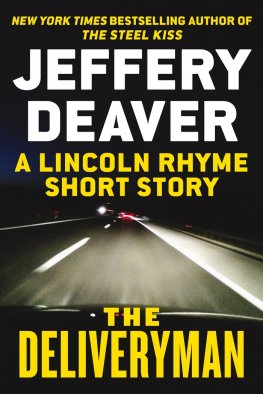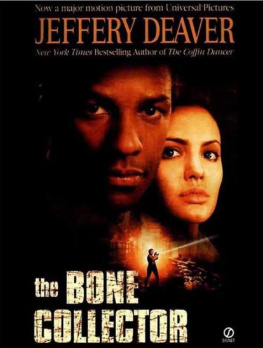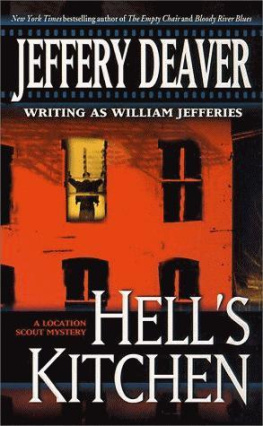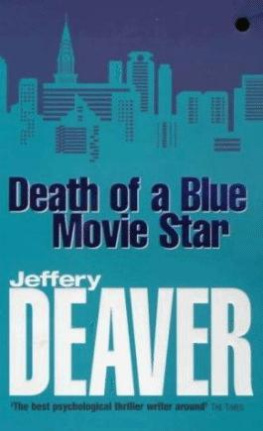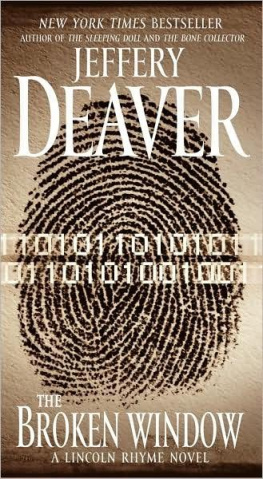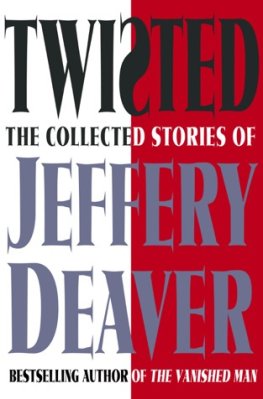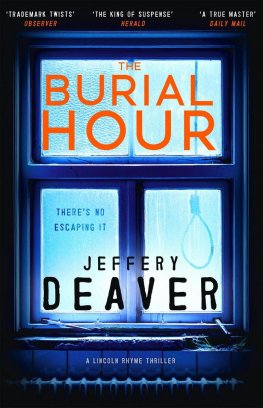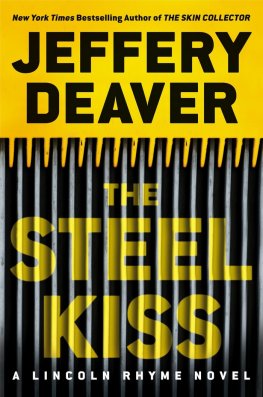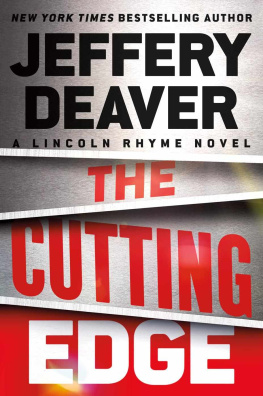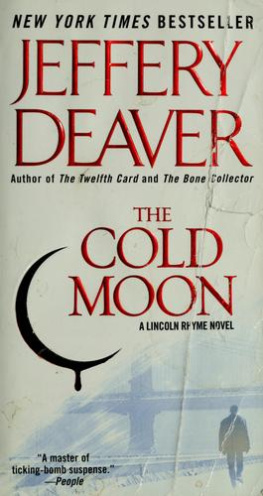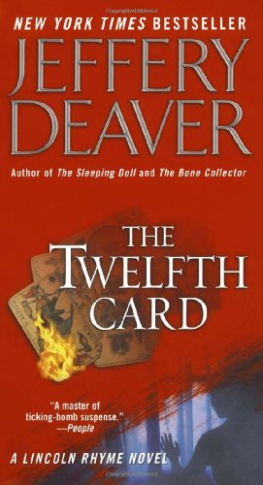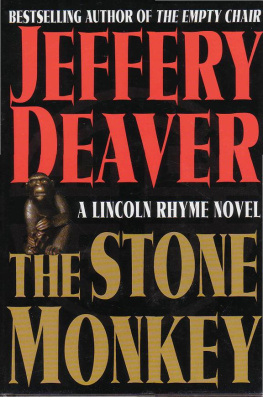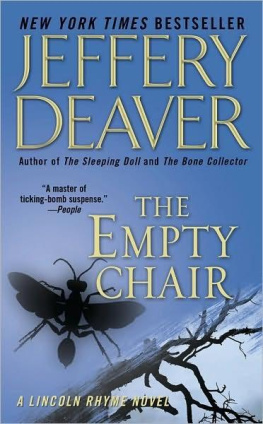Jeffery Deaver
The Deliveryman
Thursday, 8:30 p.m.
Whats the story, Sachs? How was the scene? Complicated? Difficult? Impossible?
Lincoln Rhyme turned his motorized wheelchair from his computer, where hed been reading an email, toward the arched doorway of his parlor.
Amelia Sachs was walking into his parlor-cum-laboratory on Central Park West. She deposited on a nearby evidence table the large gray milk crate she was lugging, then pulled off her black 511 tactical jacket. She was clothed in blue jeans and a T-shirt off-white today that were typical of what she wore beneath the Tyvek overalls when she walked the grid at a crime scene. Her pretty face, her former fashion model face, eased into a smile. The scene? Challenging, lets say. Youre in a good mood.
He is. Its pretty disorienting. This came from Rhymes aide just entering the room behind Sachs. Thom Reston, a slim young man, was impeccably dressed in dark gray Italian slacks and a solid taupe shirt. Rhyme was a quadriplegic his spine damaged at the C4 level and largely paralyzed from the neck down. Accordingly, and not surprisingly, he was given to swings of temperament that could be quite dramatic. (Of course, even before the accident that rendered him disabled, as head of the NYPD crime scene operation, hed been dour to insufferable quite often, hed been fast to admit.) Thom was in a good position to voice an opinion on the matter; after years of caregiving, he knew his charges emotional gravity quite well, the way one half of a long-married couple knows the others by instinct.
My moods are hardly relevant. Why would they be? His eyes were on the crate containing evidence from the complicated, difficult and, if not impossible, then challenging homicide scene Sachs had just run in Manhattan.
Sachs seemed amused by the half-hearted denial. She asked, The Baxter case?
If I were in a good mood though again, irrelevant that might be a source.
The Baxter prosecution had been a particularly tough one, unique for Rhyme; he could not recall handling another purely white collar criminal case in his years as an NYPD detective or, more recently, a forensic consultant. Baxter, an Upper Eastsider/Long Islander, had been charged with scamming millions from other Upper Eastsider/Long Islanders (true, the vics came from all over the New York metro area but were all of the same pedigree). Most could probably afford to lose the money but, wherever your socialist or income inequality sympathies lay, one cannot take what belongs to others. The former stockbroker and bond trader devised exceedingly clever financial scams that had hummed away, undetected, for several years. An assistant DA had discovered the schemes, though, and shed asked Rhyme to assist on the evidentiary side of the case. Hed had to bring all his forensic skills to the game to identify cash trails, drop sites, remote locations from which pay phone and other landline calls were made, meetings in restaurants and bars and state parks, physical presence on private jets, relevant documents and objets dart purchased with stolen cash.
Rhyme had managed to pull together enough evidence for a conviction on wire fraud and larceny and other financial offenses but, not content with those crimes alone, he kept digging... and found that Baxter was more of a threat than it seemed at first glance. Rhyme had found evidence that hed participated in at least one shooting and discovered an illegal pistol hidden in a self-storage unit. The detectives and DA couldnt find any physical victims; it was speculated that hed simply intimidated some poor mark with a well-placed .45 shot or two. The absence of a bullet-riddled victim, though, was irrelevant; possessing a handgun without proper license was a serious felony. The DA added the charge and, just today, the jury returned a guilty-on-all-counts verdict.
Lincoln Rhyme lived for the okay challenge of forensic work and once his contribution to a case was finished, he grew uninterested. Today, however, the ADA had just sent Rhyme an email in which she reported the verdict while adding a footnote: One of the victims scammed by Baxter out of her nest egg had tearfully thanked the prosecutor and anyone else who helped in the trial. The guilty verdict meant she would have a much easier path in suing Baxter to recoup some of the stolen funds. Shed be able to send her grandchildren to college, after all.
Rhyme regarded sentiment as perhaps the least useful of emotions, yet he was pleased at his contribution to People v. Baxter. Hence the, yes, good mood.
But Baxter was going into the system, Rhymes role was over and so: Time to get back to work. He inquired once more about the homicide scene Sachs had just run in Manhattan.
She responded, Victim was thirty-eight-year-old Eduardo Echi Rinaldo, worked as a deliveryman. Had his own company, legit. But he also did a little street dealing grass and coke mostly and transported whatever the crews needed moved, which was a little less than legit: stolen merch, drugs, even undocumenteds.
Bodies?
Thats right. Well, live ones. She shrugged. He was freelance, worked for anybody who paid, but mostly the Latino crews. GT had next to nothing on him.
The Organized Crime Divisions Gang Taskforce, operating out of NYPD headquarters at One Police Plaza, was unequaled in tracking crews in the metro area. If GT didnt have info on the late Echi he was insignificant indeed.
So gangsve taken to outsourcing, he mused.
Why pay benefits and retirement plans, you can avoid it? She smiled and continued, He was slashed to death in an alley and I mean slashed. Dont have the weapon but Id say serrated blade. Jugular, wrists. He tried to crawl to the street but didnt get very far. Bled out, ME says, in two, three minutes.
The perp mustve known what he was doing. The vast majority of stab wounds are superficial, and quick death from a sharpened edge requires attention to important veins and arteries.
Rhymes eyes had turned to the milk crate shed brought in. Thats all you collected?
The doorbell sounded and Thom went to answer it. Rhyme noticed Sachs give a faint and, it seemed to him, wry laugh.
He saw why a moment later. Two ECTs walked into the lab wheeling hand trucks on which were bungeed a dozen milk crates similar to the one Sachs had just carried in by herself. Each crate was filled to overflowing.
Ask and ye shall receive, Sachs said.
Thats from one scene? Rhyme asked.
You wanted impossible.
Not that impossible.
Shed collected, by his count, perhaps five hundred items of evidence from the Rinaldo killing. As every criminalist knew, too much evidence was as troublesome as not enough.
She said, Weve got cigarette butts, roach clips, food wrappers, coffee cups, a kids toy, beer cans, broken bottles, condoms, scraps of paper, receipts. It was one messy alley.
Jesus.
Sachs greeted the evidence collection techs both women, Latina and Anglo and directed them to place what theyd brought on examination tables. The darker-skinned woman cast a worshipful gaze toward Rhyme. Not many evidence collection techs entry level at CSU got a glimpse of the legendary criminalist.
Rhyme gave a neutral tip of the head; he had as little need for reverence as he did for sentiment, probably less.
Sachs, however, thanked them and referred to some social get-together with one or both or someone else that was in the works and they left.
Her phone hummed and she took a call, stepped aside to speak for a moment. Her face was grim. Rhyme deduced, though he wasnt certain, that the call was personal. Her mother had been having serious health issues lately cardiac surgery loomed and Sachs, both his professional and romantic partner, had been preoccupied with the womans condition lately.

